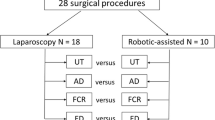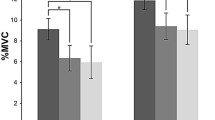Abstract
Background
Women surgeons may experience more ergonomic challenges while performing surgery. We aimed to assess ergonomics between men and women surgeons.
Methods
Laparoscopic surgeons from a single institution were enrolled. Demographics and intraoperative data were collected. Muscle groups were evaluated objectively using surface electromyography (EMG; TrignoTM, Delsys, Inc., Natick, MA), and comprised upper trapezius (UT), anterior deltoid, flexor carpi radialis (FCR), and extensor digitorum (ED). Comparisons were made between women (W) and men (M) for each muscle group, assessing maximal voluntary contraction (MVC) and median frequency (MDF). The Piper Fatigue Scale-12 (PFS-12) was used to assess self-perceived fatigue. Statistical analyses were performed using SPSS v26.0, α = 0.05.
Results
18 surgeries were recorded (W:8, M:10). Women had higher activation of UT (32% vs 23%, p < 0.001), FCR (33% vs 16%, p < 0.001), and ED (13% vs 10%, p < 0.001), and increased effort of ED (90.4 ± 18.13 Hz vs 99.1 ± 17.82 Hz). Comparisons were made between W and M for each muscle group, assessing MVC and MDF.
Conclusions
After controlling for surgeon’s height and duration of surgery, an increase in muscle activation was seen for women laparoscopic surgeons. Since poor ergonomics could be a major cause of work-related injuries, we must understand differences in ergonomics between men and women and evaluate which factors impact these variations.


Similar content being viewed by others
References
Catanzarite T, Tan-Kim J, Menefee SA (2018) Ergonomics in gynecologic surgery. Curr Opin Obstet Gynecol 30(6):432–440
Catanzarite T, Tan-Kim J, Whitcomb EL, Menefee S (2018) Ergonomics in surgery: a review. Female Pelvic Med Reconstr Surg 24(1):1–12
Lloyd GL, Chung ASJ, Steinberg S, Sawyer M, Williams DH, Overbey D (2019) Is your career hurting you? The ergonomic consequences of surgery in 701 urologists worldwide. J Endourol 33(12):1037–1042
van Det MJ, Meijerink WJ, Hoff C, Totte ER, Pierie JP (2009) Optimal ergonomics for laparoscopic surgery in minimally invasive surgery suites: a review and guidelines. Surg Endosc 23(6):1279–1285
Armijo PR, Huang CK, High R, Leon M, Siu KC, Oleynikov D (2019) Ergonomics of minimally invasive surgery: an analysis of muscle effort and fatigue in the operating room between laparoscopic and robotic surgery. Surg Endosc 33(7):2323–2331
Kokosis G, Dellon LA, Lidsky ME, Hollenbeck ST, Lee BT, Coon D (2019) Prevalence of musculoskeletal symptoms and ergonomics among plastic surgery residents: results of a national survey and analysis of contributing factors. Ann Plast Surg. 85:310–315
Dianat I, Bazazan A, Souraki Azad MA, Salimi SS (2018) Work-related physical, psychosocial and individual factors associated with musculoskeletal symptoms among surgeons: implications for ergonomic interventions. Appl Ergon 67:115–124
Perez-Duarte FJ, Sanchez-Margallo FM, Diaz-Guemes Martin-Portugues I, Sanchez-Hurtado MA, Lucas-Hernandez M, Uson GJ (2012) Ergonomics in laparoscopic surgery and its importance in surgical training. Cir Esp 90(5):284–291
Sutton E, Irvin M, Zeigler C, Lee G, Park A (2014) The ergonomics of women in surgery. Surg Endosc 28(4):1051–1055
Heiser S (2018) Women were majority of US medical school applicants in 2018. AAMCNews, The Association of American Medical Colleges, Washington, D.C.
Park A, Lee G, Seagull FJ, Meenaghan N, Dexter D (2010) Patients benefit while surgeons suffer: an impending epidemic. J Am Coll Surg 210(3):306–313
Epstein S, Tran B, Capone A, Ruan Q et al (2018) Work-related musculoskeletal disorders among plastic surgeons: a systematic review. J Reconstr Microsurg 34:553–562
Janki S, Mulder EEAP, IJzermans JNM, Tran TCK (2017) Ergonomics in the operating room. Surg Endosc 31:2457–2466
Kokosis G, Dellon LA, Lidsky ME, Hollenbeck ST, Lee BT, Coon D (2019) Prevalence of musculoskeletal symptoms and ergonomics among plastic surgery residents: results of a national survey and analysis of contributing factors. Ann Plast Sur 85:310–315
Berguer R, Hreljac A (2004) The relationship between hand size and difficulty using surgical instruments: a survey of 726 laparoscopic surgeons. Surg Endosc 18(3):508–512
Shepherd JM, Harilingam MR, Hamade A (2016) Ergonomics in laparoscopic surgery—a survey of symptoms and contributing factors. Surg Laparosc Endosc Percutan Tech 26(1):72–77
Blackwell JR, Kornatz KW, Heath EM (1999) Effect of grip span on maximal grip force and fatigue of flexor digitorum superficialis. Appl Ergon 30(5):401–405
Adams DM, Fenton SJ, Schirmer BD, Mahvi DM, Horvath K, Nichol P (2008) One size does not fit all: current disposable laparoscopic devices do not fit the needs of female laparoscopic surgeons. Surg Endosc 22(10):2310–2313
González-Sánchez M, González-Poveda I, Mera-Velasco S, Cuesta-Vargas AI (2017) Comparison of fatigue accumulated during and after prolonged robotic and laparoscopic surgical methods: a cross-sectional study. Surg Endosc 31(3):1119–1135
Author information
Authors and Affiliations
Corresponding author
Ethics declarations
Disclosures
Dr. Dmitry Oleynikov is the stockholder for Virtual Incision Corporation, nonrelated to the current work. Dr. Rodrigues Armijo, Ms. Laura Flores, Dr. Bhavani Pokala, Dr. Chun-Kai Huang, and Dr. Joseph Siu have nothing to disclose.
Additional information
Publisher's Note
Springer Nature remains neutral with regard to jurisdictional claims in published maps and institutional affiliations.
Rights and permissions
About this article
Cite this article
Armijo, P.R., Flores, L., Pokala, B. et al. Gender equity in ergonomics: does muscle effort in laparoscopic surgery differ between men and women?. Surg Endosc 36, 396–401 (2022). https://doi.org/10.1007/s00464-021-08295-3
Received:
Accepted:
Published:
Issue Date:
DOI: https://doi.org/10.1007/s00464-021-08295-3




